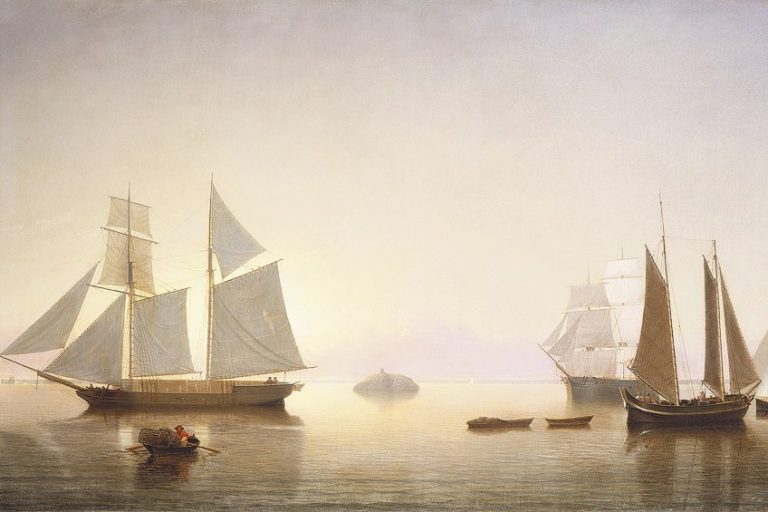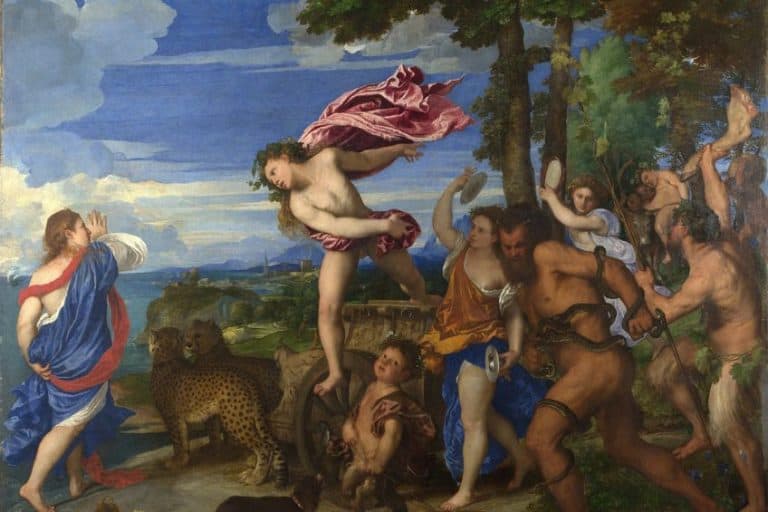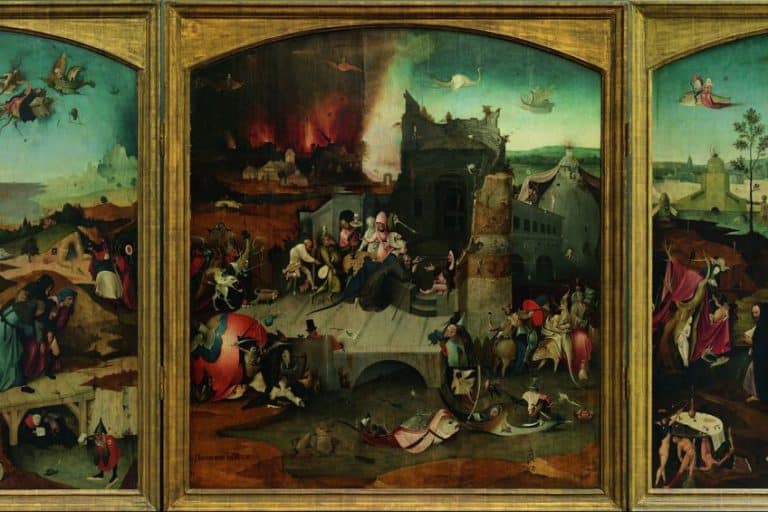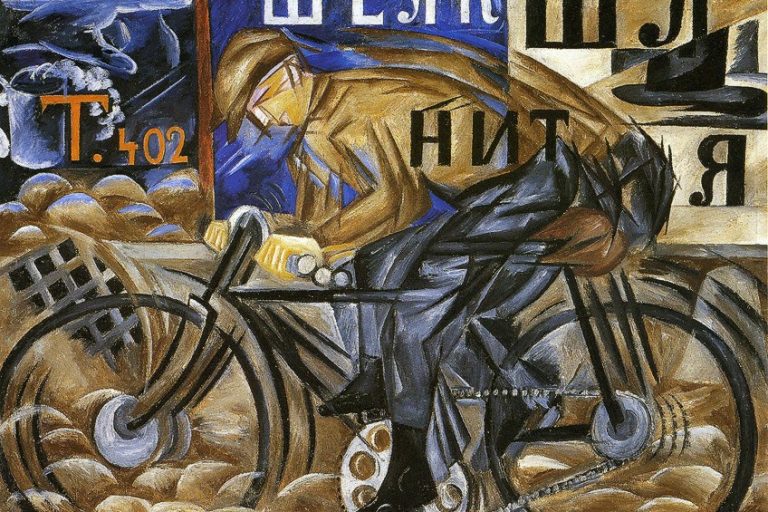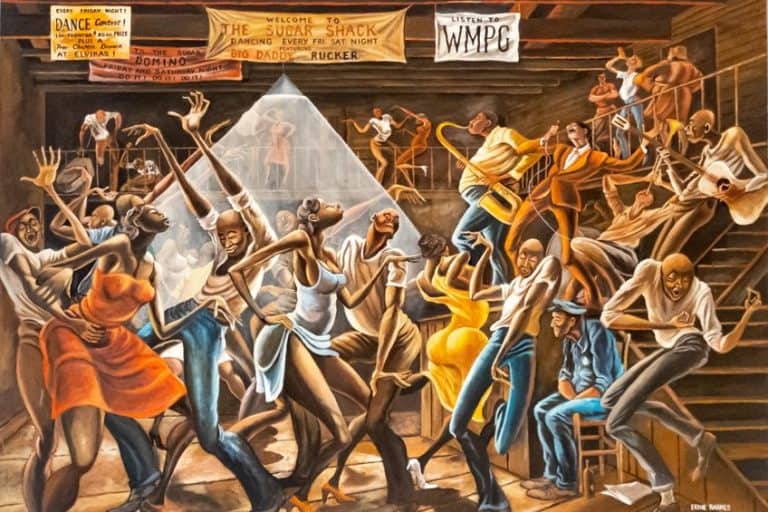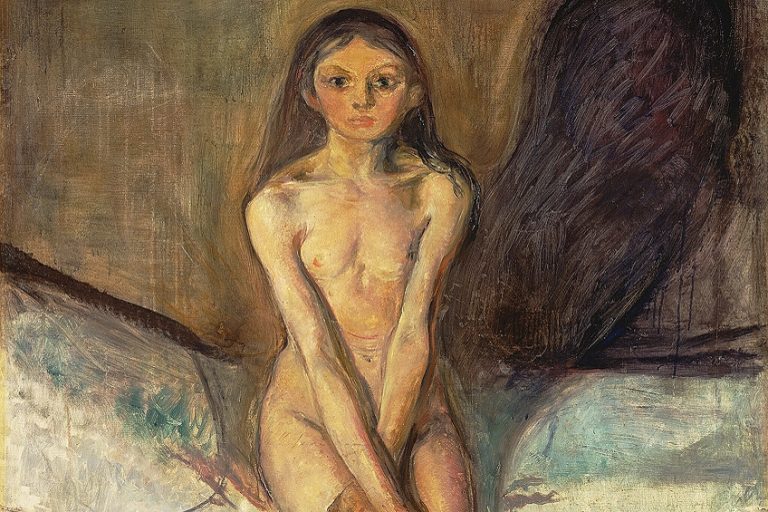“The Sleep of Reason Produces Monsters” by Goya – A Look
The print series titled Los Caprichos was one of Francisco Goya’s most prominent artworks, and it revealed many deeper truths about human behavior with a somewhat haunting darkness to its subject matter. This article will explore the more popular print titled The Sleep of Reason Produces Monsters (c. 1796 – 1798), which was number 43 in the series, and was almost the first page of the series.
Artist Abstract: Who Was Francisco Goya?
Francisco Goya was born on March 30, 1746, in Fuendetodos in Aragon, Spain, and died on April 16, 1828, in Bordeaux, France. He started studying painting when he was 14 years old under the tutelage of the Baroque painter José Luzán and later under Anton Raphael Mengs, however, their relationship was reportedly conflicted.

He was also a court painter from 1786, a position he held for a few years during his art career. Goya was part of the Romanticism art style and is often described as one of the “Old Masters” of art and one of the first “Modern artists”. A few of his famous artworks include The Nude Maja (c. 1797 – 1800), The Third of May, 1808 (1814), and Witches’ Sabbath (1821 – 1823).
The Sleep of Reason Produces Monsters (c. 1796 – 1798) by Francisco Goya in Context
| Artist | Francisco Goya (1746 – 1828) |
| Date Created | c. 1796 – 1798 |
| Date Published | 1799 |
| Medium | Etching, aquatint, drypoint, and burin |
| Genre | |
| Period/Movement | Romanticism |
| Dimensions (centimeters) | c. 21.2 x 15 |
| Series/Versions | Number 43 of a series of 80 prints titled Los Caprichos (c. 1796 – 1798) |
| Where Is It Housed? | The Metropolitan Museum of Art, New York City, United States |
| What It Is Worth | The exact price is uncertain |
The Sleep of Reason Produces Monsters (c. 1796 – 1798) analysis will first discuss a contextual overview, introducing more about how this etching originated and the Los Caprichos series it is a part of. It will be followed by a formal analysis that will explore the subject matter including how the art elements and principles compose it.
Contextual Analysis: A Brief Socio-Historical Overview
The Sleep of Reason Produces Monsters by Francisco Goya is the 43rd print from a series of 80 etching and aquatint prints titled Los Caprichos, the latter of which means “The Caprices” in English. Goya was believed to have created these between 1796 to 1798. Before we explore what has been touted as one of the more popular prints, The Sleep of Reason Produces Monsters, let us first discuss the series and its meaning.
Goya published the first edition of the Los Caprichos series in 1799. He advertised it in the Diario de Madrid newspaper on February 6, stating what the series was about, its price, reportedly 320 reales, and where it could be purchased.

The address Goya provided was reportedly at a liquor and perfume shop, which was around where he lived, the latter was at Number One Calle del Desengaño (otherwise in English known as “Disappointment Street”) in Madrid. Unfortunately, Goya’s venture did not sell well; he only sold 27 sets, and reportedly he had 300 sets of his Los Caprichos series. Soon after he stopped selling the sets and reportedly exchanged these for his son’s pension with King Charles IV.
Further reasons why Goya took the sets off the market was because he reportedly wanted to steer clear of the Spanish Inquisition.
What Does the Los Caprichos by Francisco Goya Mean?
The satirical series of prints titled Los Caprichos is Spanish for “The Caprices”, which means follies. These prints all depict circumstances that convey a variety of “follies” associated with human beings and their actions, which are depicted through the lenses of demons, witches, goblins, and supernatural phenomena.
There are numerous interpretations around the meaning of Los Caprichos, from the artist’s own satirical gaze on his society and its classes and systems to his personal challenges, the latter of which refers to an illness in 1792 that left Goya deaf, and all of which could have influenced what he chose to depict in Los Caprichos.
However, it is important to go to the source and refer to what Goya stated in his advertisement of Los Caprichos in the Diario de Madrid. He stated that his series depicted in his subject matter the “multitude of eccentricities and errors that are common in every civil society”. Furthermore, he stated how he chose his subject matter, notably “among the prejudices and common falsehoods authorized by habit, ignorance or interest”.
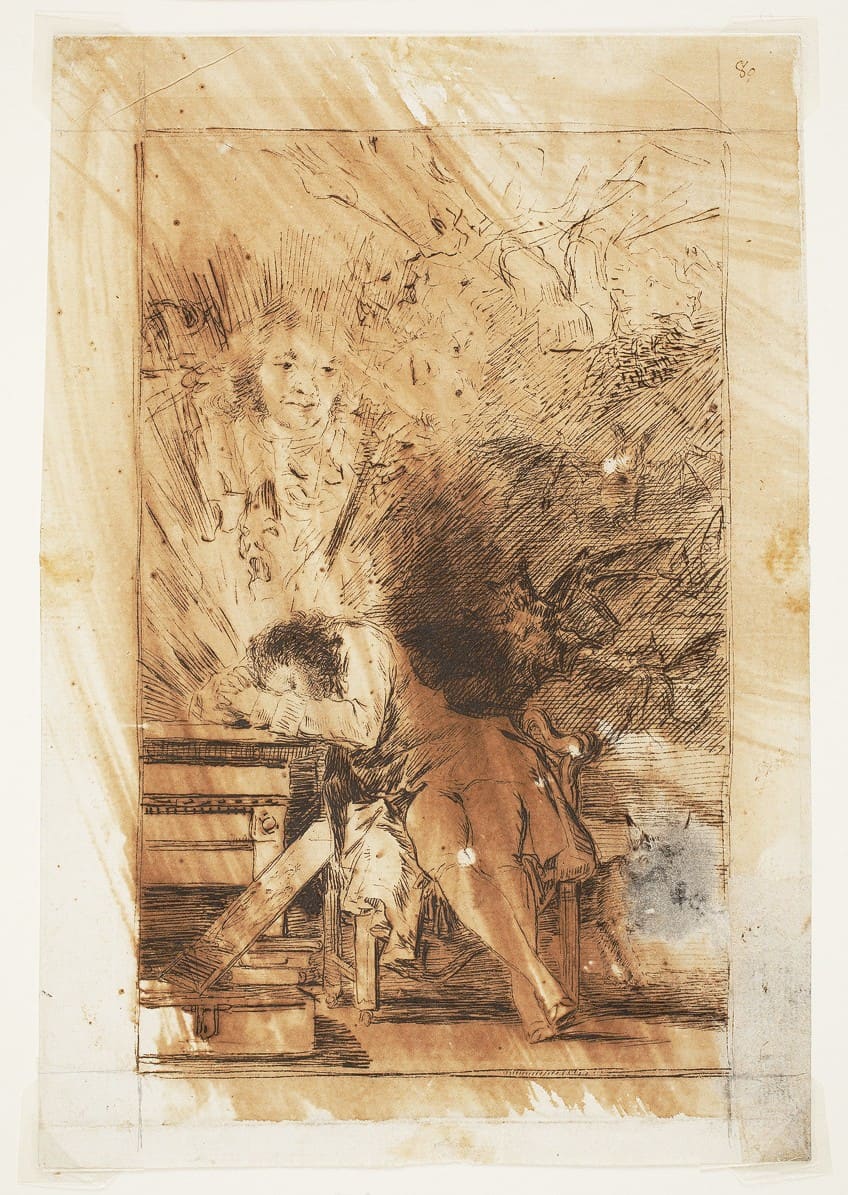
Additionally, Los Caprichos has also been interpreted socio-politically, especially the time in which Goya lived and what he would have experienced, notably related to the Enlightenment, or “Age of Reason”, which was an era in Europe that focused on science and philosophy-based ideals like reason, intellectualism, rationality, and more. The Enlightenment era reached an ending around the French Revolution in 1789 and the early 1800s, which was also during the Napoleonic War that lasted from 1803 to 1815. Goya’s Los Caprichos was published in 1799, on the cusp of the Enlightenment’s finality, from which Romanticism developed in reaction to it.
From this, art became more expressive and feeling-based, with ideals that were opposite to that of reason or rationality with a focus on the importance of emotions, subjectivity, and often nature.
Another common interpretation has been noted as relating to dreams/fantasy/monsters/evil and rationality, or reason, and the interrelationship between these two and how they affect human beings. Goya reportedly included a caption with his famous print that this article is focused on, The Sleep of Reason Produces Monsters, which expands on the above-mentioned interrelationship between dreams and reason and how they affect humans and the process of art making.
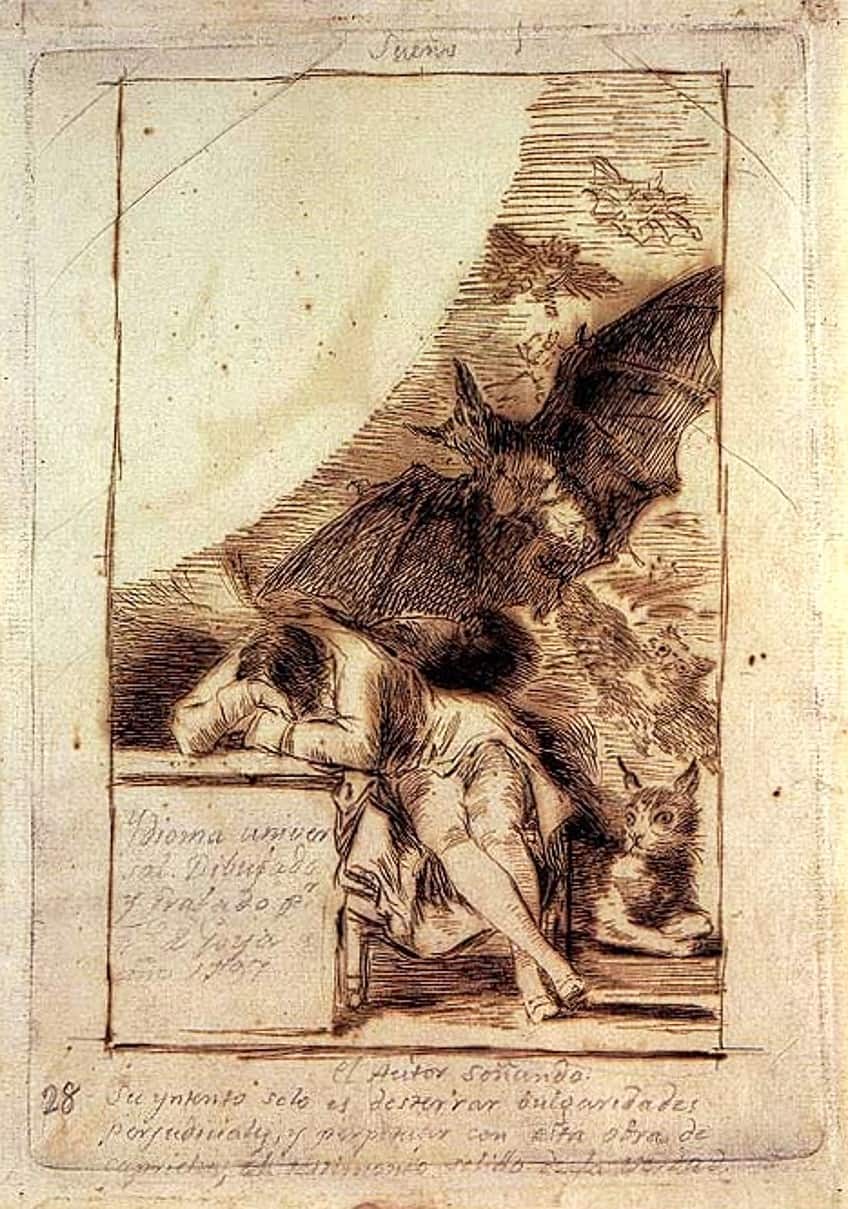
The caption states, “Imagination abandoned by reason produces impossible monsters; united with her, she is the mother of the arts and source of their wonders”. This can also be viewed in the light of the above-mentioned differences between the Enlightenment and Romanticism ideals.
Furthermore, some of the common symbolic interpretations that inform the meaning of Francisco Goya’s Sleep of Reason Produces Monsters and its subject matter, notably the cats, bats, and owls, have been linked to the idea of melancholy.
Another significant note to remember about the portrayed animals is that they have been given various symbolic meanings by various sources. One of their primary representations is that they are the so-called monsters in this composition and depicted with a foreboding energy that flutters around the sleeping man. These nocturnal animals are also associated with aspects of the night. Some sources have suggested that these could also symbolize ignorance or aspects of darkness, which is associated with evil.
Formal Analysis: A Brief Compositional Overview
The formal analysis below will discuss The Sleep of Reason Produces Monsters by Francisco Goya in more detail in terms of its subject matter and stylistic composition. The latter will be discussed in terms of categories according to the main art elements of color, value, texture, line, shape, form, and space with mention of the visible art principles.
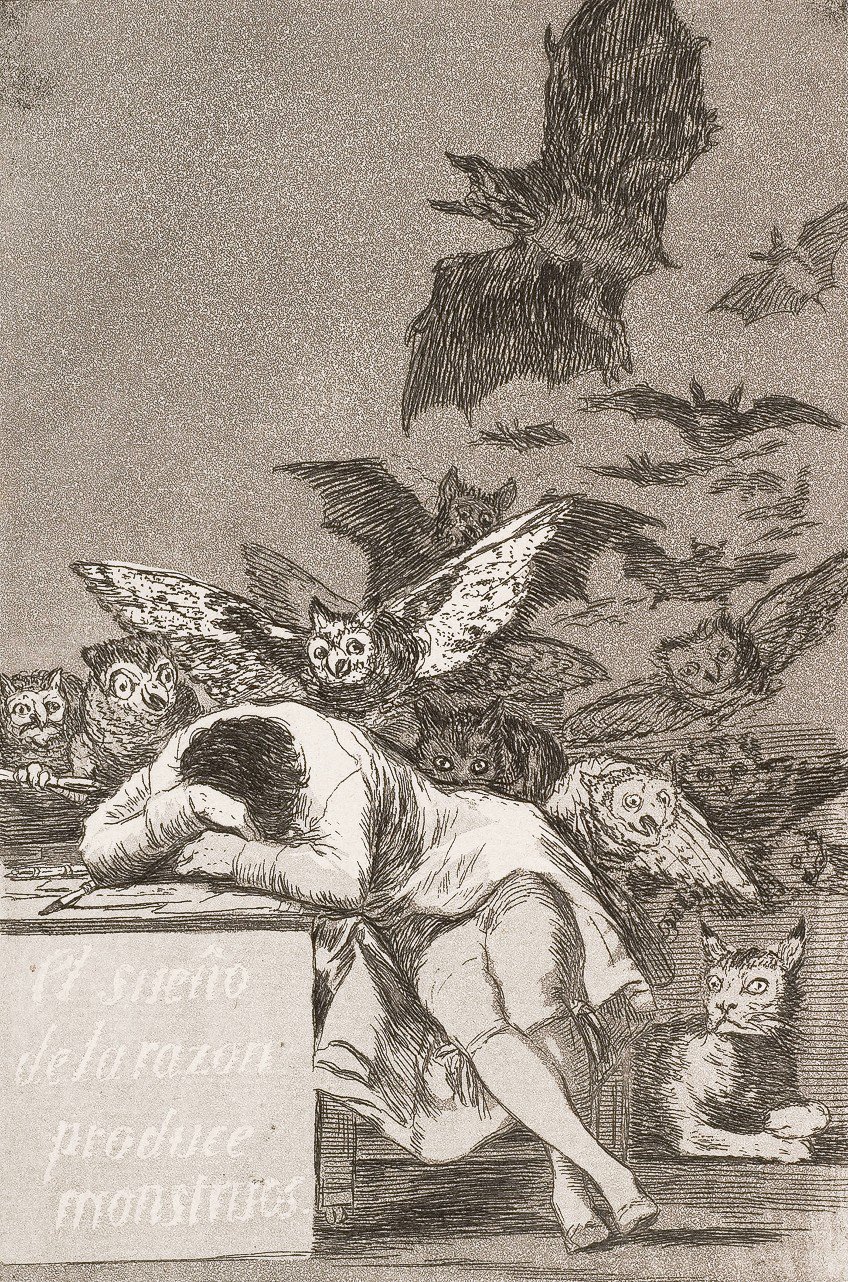
Subject Matter: Visual Description
The etching of The Sleep of Reason Produces Monsters by Francisco Goya depicts a man seated in his chair at his desk, which is in the bottom left corner of the composition. Written on the front of the desk are the Spanish words, “El Sueño de la Razon Produce Monstruos”, which means “The Sleep of Reason Produces Monsters” in English.
The man, however, is asleep, leaned over in his chair, legs crossed and feet on the floor, and his head is resting on his folded arms on his desk. Surrounding the man are owls, bats, and cats while he sleeps. On his desk are pieces of paper and pens.
There is a large owl, with outstretched wings, on the man’s upper back. Further down, and what appears to be behind him and partially on him, is a skulking black cat-like creature, its two large open eyes looking directly at us, the viewers.

Just below this cat-like creature is another large owl on the man’s right side and it appears to be balancing on the man’s side or on the chair. Lying on the floor on the man’s left (our right) and slightly behind his chair, is a lynx, with its left paw over its right paw. It appears to be looking in the man’s direction and its eyes are wide open and engaged in what is around it.
To the man’s right (our left) are two other bird-like creatures, possibly owls. They appear to be looking at and making a noise at him.
The owl closest to him has what appears to be a crayon holder in its claw and directs it at the sleeping man, who is none the wiser. The background consists of owls and bats in flight with an oversized bat filling the upper right corner of the composition and somewhat looming over the sleeping man. They appear mostly on the right side, leaving the upper left side of the composition an empty space without any other subject matter depicted.
Color and Value
The color and value in The Sleep of Reason Produces Monsters by Francisco Goya consist of the level of shading done through the etching process. Some areas are lighter, and some are darker, for example, the figure of the man appears lighter compared to the darker parts of the flying owls and bats. Darker areas also suggest shadows, for example, underneath the man’s chair or the smaller sliver of a shadow cast by his feet.
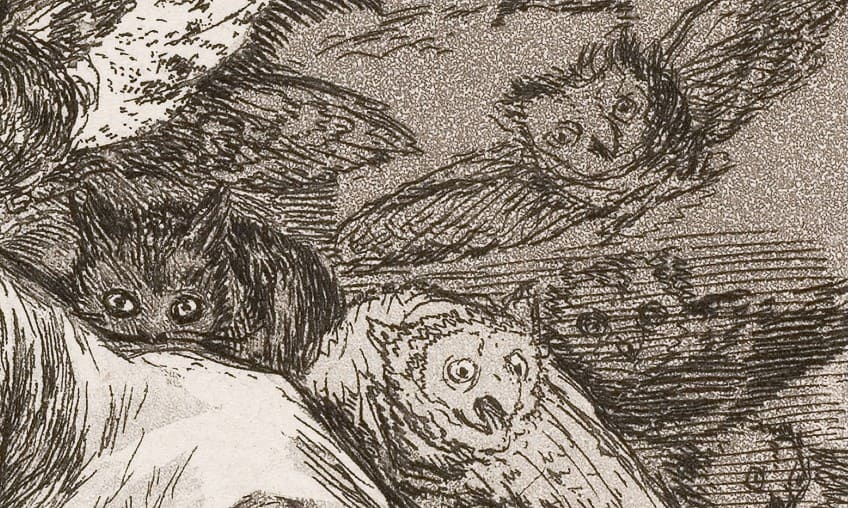
Texture
Francisco Goya implied various textures through his etching techniques, for example, the softer folds of the man’s coat compared to the harder surface of the table on the left. The owls’ feathers have various patterns on them from scribbles of lines that also imply their feathery softness.
The lynx’s fur is implied through short, repetitive lines.
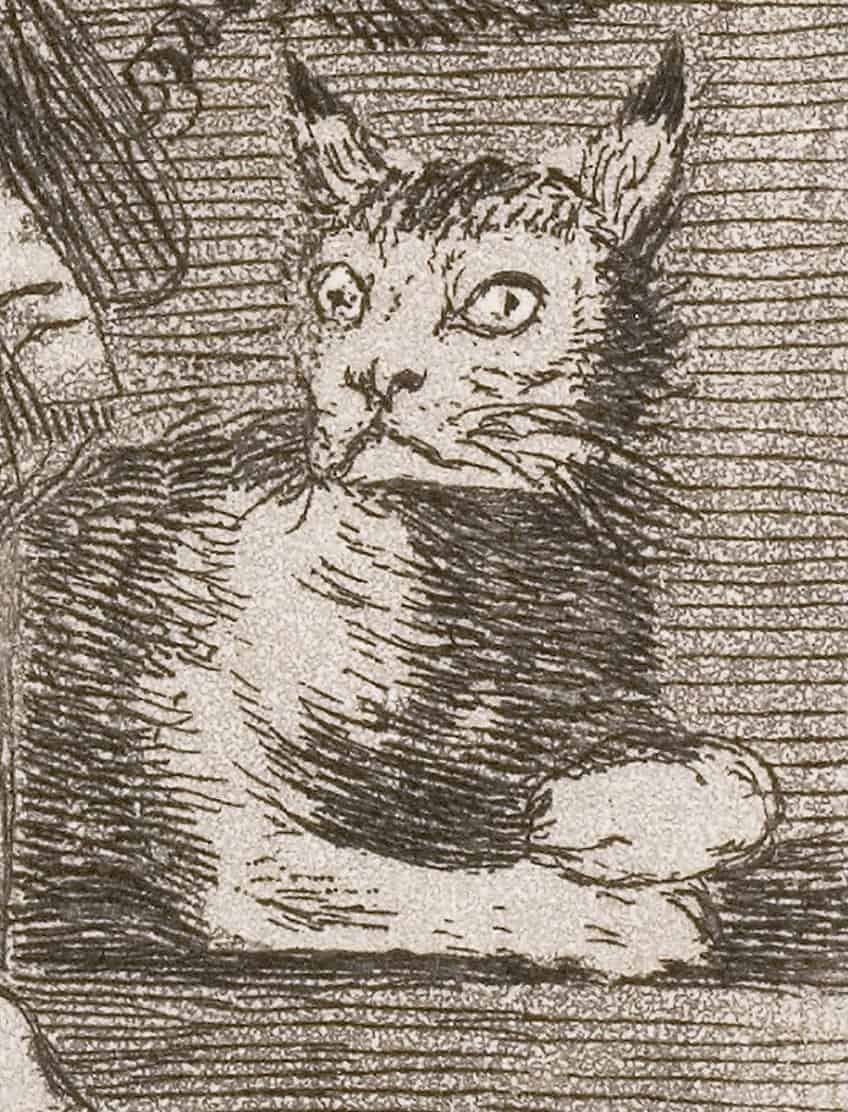
Line
There are a variety of lines in The Sleep of Reason Produces Monsters by Francisco Goya, all of which delineate the shapes and forms of the subject matter. The lines are also in varying shades, repetitions, and patterns that also add the effect of depth to the composition. For example, notice the rows of thin lines on the lower right, which provide the effect of shadows in the background, and as the bats diminish into the background they start to appear as mere scribbles.

Shape and Form
There are naturalistic shapes and forms, in The Sleep of Reason Produces Monsters by Francisco Goya. These consist of the figures of the man and the various animals. Some geometric shapes occur in the table on the left, which is a square-like shape.

Space
By utilizing color, line, and size, Francisco Goya depicted a sense of three-dimensional space. He created depth by utilizing contrasts between dark and light, for example, the bats in the background appear lighter, less defined, and smaller in size, which suggests they are further away, while the bats that are closer appear darker, more defined, and larger in size. Furthermore, Goya left an empty, negative, space to the left of the painting, and filled the right side with the fluttering and flying owls and bats. This creates a unique composition and creates a patterned effect.

Beyond Dreaming and Into Reality
While this article focused on The Sleep of Reason Produces Monsters by Francisco Goya, it also touched on deeper truths that relate to the artist’s other artworks. During his art career, Goya created several other series, namely Disasters of War (c. 1810 – 1820), which consisted of 80 prints and was published in 1863, and his popular series titled Black Paintings (c. 1819 to 1823), which were 14 paintings.

These series depicted the darker depths of Goya’s psyche and ultimately his life experiences, and along with his Los Caprichos series, he ultimately touched on pertinent issues like war, religion, superstition, human error, and more, that permeated not only the 18th and 19th-century societies but continue to this day.
Goya’s The Sleep of Reason Produces Monsters is one of the artist’s most famous examples of his prints from his Los Caprichos series. It is a testament to the time in history it was from and an example of the societal shifts, from Enlightenment to Romanticism. Furthermore, it was an example of Goya’s own personal challenges faced in his life, all of which have shaped this artwork as something more than a dream, as it exists as a representation of reality and human existence.
Frequently Asked Questions
What Is The Sleep of Reason Produces Monsters?
The Sleep of Reason Produces Monsters (c. 1796 – 1798) is an etching by the Romanticist Francisco Goya. It is number 43 of the series of 80 prints that the artist created titled Los Caprichos (c. 1796 – 1798). The series was published in 1799 and advertised in the newspaper, Diario de Madrid, on February 6, 1799.
What Is the Meaning of Francisco Goya’s The Sleep of Reason Produces Monsters?
Francisco Goya’s famous The Sleep of Reason Produces Monsters etching is often believed to be a self-portrait of the artist. While there is considerable depth to it, it touches on the complex relationship between imagination and reason, and how it affects and informs art. It has also been viewed politically.
When Did Francisco Goya Create The Sleep of Reason Produces Monsters?
It is estimated that Francisco Goya started creating his etching series, Los Caprichos, between 1796 up until 1798, of which The Sleep of Reason Produces Monsters was a part of. He published the series in 1799, advertising it in the Diario de Madrid newspaper on February 6.
Alicia du Plessis is a multidisciplinary writer. She completed her Bachelor of Arts degree, majoring in Art History and Classical Civilization, as well as two Honors, namely, in Art History and Education and Development, at the University of KwaZulu-Natal, South Africa. For her main Honors project in Art History, she explored perceptions of the San Bushmen’s identity and the concept of the “Other”. She has also looked at the use of photography in art and how it has been used to portray people’s lives.
Alicia’s other areas of interest in Art History include the process of writing about Art History and how to analyze paintings. Some of her favorite art movements include Impressionism and German Expressionism. She is yet to complete her Masters in Art History (she would like to do this abroad in Europe) having given it some time to first develop more professional experience with the interest to one day lecture it too.
Alicia has been working for artincontext.com since 2021 as an author and art history expert. She has specialized in painting analysis and is covering most of our painting analysis.
Learn more about Alicia du Plessis and the Art in Context Team.
Cite this Article
Alicia, du Plessis, ““The Sleep of Reason Produces Monsters” by Goya – A Look.” Art in Context. December 25, 2023. URL: https://artincontext.org/the-sleep-of-reason-produces-monsters-by-goya/
du Plessis, A. (2023, 25 December). “The Sleep of Reason Produces Monsters” by Goya – A Look. Art in Context. https://artincontext.org/the-sleep-of-reason-produces-monsters-by-goya/
du Plessis, Alicia. ““The Sleep of Reason Produces Monsters” by Goya – A Look.” Art in Context, December 25, 2023. https://artincontext.org/the-sleep-of-reason-produces-monsters-by-goya/.




